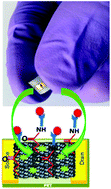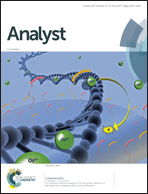A multi-walled carbon nanotube–zinc oxide nanofiber based flexible chemiresistive biosensor for malaria biomarker detection†
Abstract
We report the fabrication of a flexible, lightweight and disposable multi walled carbon nanotube (MWCNT)–zinc oxide (ZnO) nanofiber based chemiresistive biosensor for label free detection of the malaria biomarker, histidine rich protein II (HRP2). The sensing platform is formed by depositing nanofibers in between the source and drain electrodes patterned on a thin, flexible polyethylene terephthalate (PET) substrate. MWCNT–ZnO nanofibers are synthesized via the electrospinning technique followed by a calcination process. This approach creates functional groups on the nanofiber surface that are used for the one step immobilization of HRP2 antibodies without further surface modification. The device exhibits a good sensitivity of 8.29 kΩ g−1 mL and a wide detection range of 10 fg mL−1–10 ng mL−1, and it is specific towards the targeted HRP2 biomarker. To the best of our knowledge, this is the first report on a flexible chemiresistive biosensor explored for the detection of the malaria biomarker and can be extended in the future to several other biomarker detection systems towards smart point-of-care (POC) diagnostics.



 Please wait while we load your content...
Please wait while we load your content...